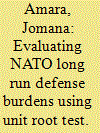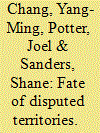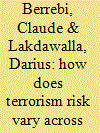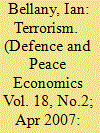| Srl | Item |
| 1 |
ID:
079647


|
|
|
|
|
| Publication |
2007.
|
| Summary/Abstract |
An ever-growing share of defence R&D expenditures is being dedicated to the development and fielding of integrative technologies that enable separate individual systems to work in a coordinated and synergistic fashion as a single system. This study explores the optimal defence budget allocation to the development and acquisition of weapon systems and to the development of integrative technologies. We develop a suitable optimization framework, and then use it to derive the optimal budget allocation and analyse its properties. Finally, we use US defence budget data to calibrate the parameters of the model and provide a quantitative measure for the apparent US military supremacy.
|
|
|
|
|
|
|
|
|
|
|
|
|
|
|
|
| 2 |
ID:
079648


|
|
|
|
|
| Publication |
2007.
|
| Summary/Abstract |
This study evaluates NATO long run defense burdens by analyzing the time-series properties of burden measures, namely growth of defense spending, defense share in national output, defense share in government spending, defense spending per capita, and defense share in total NATO spending for the time period 1949-2002. The study also compares the effect of using government Purchasing Power Parity conversion factors and Market Exchange Rates for defense share in total NATO expenditure conversions and the implications of NATO expansion in light of the defense burden measures of the newer NATO members.
|
|
|
|
|
|
|
|
|
|
|
|
|
|
|
|
| 3 |
ID:
079649


|
|
|
|
|
| Publication |
2007.
|
| Summary/Abstract |
This paper presents a simple model to characterize the outcome of a land dispute between two rival parties using a Stackelberg game. Unlike Gershenson and Grossman (2000), we assume that the opposing parties have access to different technologies for challenging and defending in conflict. We derive the conditions under which territorial conflict between the two parties is less likely to persist indefinitely. Allowing for an exogenous destruction term as in Garfinkel and Skaperdas (2000), we show that, when the nature of conflict becomes more destructive, the likelihood of a peaceful outcome, in which the territory's initial possessor deters the challenging party, increases if the initial possessor holds more intrinsic value for the disputed land. Following Siqueira (2003), our model has policy implications for peace through third-party intervention
|
|
|
|
|
|
|
|
|
|
|
|
|
|
|
|
| 4 |
ID:
079646


|
|
|
|
|
| Publication |
2007.
|
| Summary/Abstract |
We study the spatial and temporal determinants of terrorism risk in Israel, using a geocoded database of Israeli terrorist attacks from 1949 to 2004. In selecting targets, terrorists seem to respond rationally to costs and benefits: they are more likely to hit targets more accessible from their own homebases and international borders, closer to symbolic centers of government administration, and in more heavily Jewish areas. We also examine the waiting time between attacks experienced by localities. Long periods without an attack signal lower risk for most localities, but higher risk for important areas such as regional or national capitals
|
|
|
|
|
|
|
|
|
|
|
|
|
|
|
|
| 5 |
ID:
079645


|
|
|
|
|
| Publication |
2007.
|
| Summary/Abstract |
If international terrorism is on a rising trend, an important source of confirmation or refutation of this is time-series data on terrorist activity. Using chiefly data collected by the RAND/MIPT consortium we show using basic statistical analysis that in the period 1968-2005 the yearly number of all international terrorist incidents shows no trend over time, but fluctuates year on year in a random manner. On the other hand some indicators do show a definite trend over time, principally the steady rise in the number of incidents that are death-dealing in nature. A further conclusion is drawn, showing that the proportion of these incidents leading to deaths above a given level is virtually fixed.
1 This research is supported by the US Institute of Peace (USIP). The opinions, findings, and conclusions or recommendations expressed in this article are those of its author and do not necessarily reflect the views of the USIP. Data employed in this article can be obtained in their raw form from the author on request
|
|
|
|
|
|
|
|
|
|
|
|
|
|
|
|